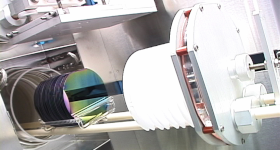POLYSILICON LPCVD WITH SILANE (SiH4)
The most widely used process gas for polysilicon LPCVD is silane (SiH4). Polysilicon LPCVD may be achieved using other alternative gases such as disilane (see Polysilicon by LPCVD with Disilane), dichloro-silane, and trichloro-silane. Each of them offers its own unique advantages depending on the area of application. Polysilicon may be doped in situ using phosphine (PH3) (see P-Doped Polysilicon by LPCVD).
- Typical Film Thickness: 0.1 to 2 µm
- Batch Size: 50 (18" flat zone) or 100 (34" flat zone)
- Deposition Rate: 6 - 20 nm/min. (60 - 200 Å/min.)
- Deposition Gases: Silane SiH4
- Deposition Temperature: 580 - 650 °C
- Index of Refraction: 3.5 - 5.5
- Uniformity: < 3% using 1 σ
- Residual Stress: 50 - 100 MPa
Applications: MEMS structures, resistors, MOSFET gates, DRAM cell plates, trench fills, bipolar transistor emitters, solar cells.
LPCVD Processes
- Silicon Carbide Devices
- Silicon Nitride Resonators
- Doped Silicon by LPCVD
- POLYSILICON LPCVD WITH SILANE (SiH4)
- POLYSILICON LPCVD WITH DISILANE (Si2H6)
- LTO, DOPED LTO, BPSG, BSG, AND PSG LPCVD
- HTO LPCVD
- TEOS LPCVD
- Silicon Nitride LPCVD
- Low-Stress Silicon Nitride LPCVD
- Stochiometric Silicon Nitride LPCVD
- Silicon Oxynitride (SiNxOy) LPCVD
- Silicon Germanium (Si-Ge) LPCVD
- SIPOS (Semi-Insulating Polycrystalline Silicon)
- Polycrystalline Silicon Carbide
- Epitaxial Silicon
- Nano Materials LPCVD



